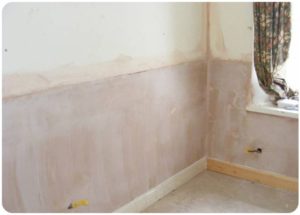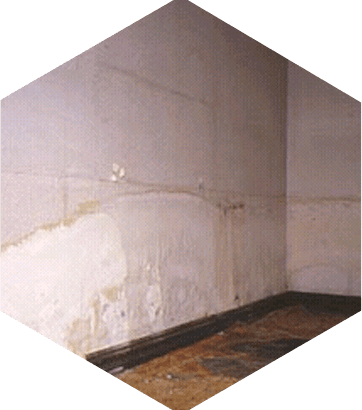Rising damp can be a serious issue if left untreated. If you have ever had this problem then you will understand the urgency people feel to get it sorted out as soon as possible and the distress that it can cause. If you are struggling with a current case of rising damp, this article will cover all the main points that will help you deal with this problem.
What is Rising Damp?
Rising damp occurs when moisture from the ground rises up through the brick or masonry walls of a building. Contrary to what most people believe, the walls of a building can act like a sponge. The visual indicators of rising damp are a stain on the wall that looks similar to a tide mark, and sometimes salt deposits. The tidemark is usually positioned quite low to the ground.

What Causes Rising Damp?
Usually a damp proof course is applied to buildings as they are being constructed in order to prevent rising damp from occurring. Unfortunately if this course is not applied correctly, or if it becomes damaged then rising damp can occur. There are other factors that can lead to rising damp such as leaking rain gutters or even problems with condensation in the building.
What are the Risks with This Type of Problem?
This kind of problem can lead to damage in decoration, plaster and even furniture. Rising damp is also potential harmful. It is a common problem and can occur in most building structures.
What to Do When You Have Rising Damp in Your Home
If for any reason you think you have a rising damp issue in your home you should contact a specialist as soon as possible in order to have them officially diagnose the problem. Without a professional diagnosis you may end up applying the wrong treatment, which will not eradicate the problem as well as delaying the correct treatment. Richardson and Starling are leading experts when it comes to problems with damp within properties. They have years of experience and expert training so you can rely on them to correctly diagnose the issue and to eradicate the issue quickly and effectively.

What Treatments Are Used?
The treatment used for rising damp will differ with each property. Variables such as property construction and site conditions can affect the treatment type used. Typically the damp specialist will have to drill holes into the base of the walls and inject a damp proof solution. The installation of a chemical damp proof course can be a cost-effective way of dealing with the issue. The purpose of the course is to form a continuous, unbroken layer of water repellent material within the wall that will act as a barrier against any dampness that rises from the ground. There are a few options for courses:
Solvent-based system
Aqueous systems
Gravity feed systems
Injection mortars
Injection creams
Electro-osmosis systems
Richardson and Starling are a great choice to deal with your rising damp problem, not only due to their expertise within the industry but also because they will re-plaster your walls after applying the damp solutions.




